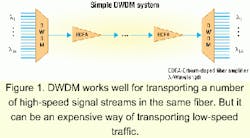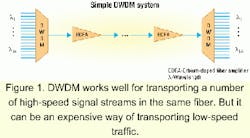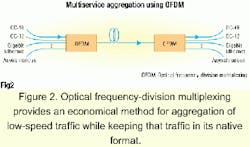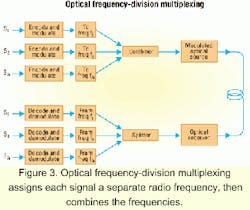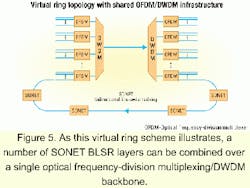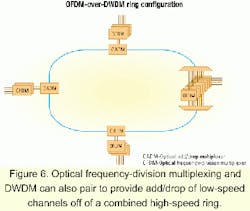Expanding capacity in the metro optical network
Optical frequency-division multiplexing, combined with DWDM, provides an effective, flexible network architecture.
DR. NORMAN L. SWENSON, Kestrel Solutions Inc.
Metropolitan service providers face an increasingly difficult challenge of expanding their networks to meet growing customer demands. In today's environment of decreasing capital budgets, the carrier must find a way to offer new revenue-generating services in a cost-effective manner. The most serious impediment is quite often the lack of sufficient fiber infrastructure, either between the central office and the customer (the access network) or between central offices (the interoffice facility or IOF network).
Installation of new fiber can be costly, labor-intensive, and time-consuming. Moreover, it can be politically unpopular, as construction often requires trenching that disrupts traffic along major thoroughfares.
Rather than installing new fiber, service providers can use technology to increase the capacity of the existing fiber network. Two methods commonly considered are time-division multiplexing (TDM) and DWDM. The recent introduction of a third technique, optical frequency-division multiplexing (OFDM), provides another tool for the service provider to maximize leverage of the embedded fiber base.
Carriers desire certain features in a multiplexing solution. The solution should have low startup cost, offering only as much capacity as is needed for initial installations. The approach should be scalable, allowing the service provider to grow capacity as demand and associated revenue increase. The solution should be flexible, capable of reconfiguration as new add and drop requirements materialize. It should be interoperable, capable of carrying the wide variety of protocols and data rates found in a metropolitan environment. And it should offer ease of operation, fitting seamlessly into the carrier's existing operational support system in a manner familiar to craft personnel.
The pairing of OFDM with DWDM in a combined multiplexing solution provides these desired features. OFDM serves as an effective bridge between lower-speed TDM and packet-based technologies and the high capacity offered by DWDM networks. This integrated solution combines the cost-effective granularity and multiservice features of OFDM with the large expansion capability of DWDM.
TDM is commonly used in telecommunication networks to combine lower-speed optical signals (the tributary signals) into a higher-capacity link. That is accomplished by interspersing the bits or bytes from the tributary signals into a single stream, requiring a common framing format and time reference among the different signals. If a signal is not already in the proper framing format, it must be "mapped" into the desired protocol. Further, slight differences in time reference between the tributaries and high-speed signal must be compensated using stuff bits or pointer processing.
In North America, SONET is the standard TDM protocol deployed today, while SDH plays a similar role in Europe and Asia. Both SONET and SDH use pointers in the overhead to compensate for any time reference differences between the lower-speed tributaries and higher-rate network clock. The overhead of a SONET or SDH tributary is terminated when it is multiplexed with other SONET/SDH signals, meaning that the overhead is not transparently carried through a higher-rate multiplexer. In principal, that should create no interoperability problem; in practice, the contrary is often the case, either due to proprietary use of overhead bytes that are supposed to be "unused" or through vendor-specific interpretations of the SONET/SDH standards.In addition to SONET and SDH equipment, a substantial part of the embedded optical network utilizes fiber-optic terminals (FOTs) using asynchronous TDM protocols that preceded development of the SONET/SDH standard. These asynchronous protocols are generally proprietary and cannot be transported using standard SONET/SDH multiplexers.
DWDM is a scalable transport technology that allows carriers to begin with a small number of wavelength channels and add wavelengths as capacity requirements increase. Unlike TDM, DWDM does not require that different signals be mapped to a common protocol or that they be re-timed to a common time reference. Multiple protocols can be transported on a single fiber, with each signal assigned to its own independent wavelength. Because the entire signal, including overhead, is transparently carried, DWDM avoids the interoperability problems that can sometimes occur with TDM.
An example of a simple DWDM system is illustrated in Figure 1. In this example, 16 wavelengths (λ1, λ2, λ3,..., λ16) are multiplexed onto a single fiber at a transmit terminal and demultiplexed at the receive terminal. Optical amplifiers (erbium-doped fiber amplifiers-EDFAs) are situated along the transmission path to boost the signal strength. At the destination, the 16 wavelengths are demultiplexed into separate channels.While the bit-rate-independence and protocol transparency of DWDM can alleviate interoperability problems, by itself it does not offer a cost-effective means of multiplexing the lower-rate signals often found in a metropolitan market. The optical components required for each wavelength are expensive. This expense is not justified when each wavelength is dedicated to a low-rate signal.
OFDM provides the means to efficiently collect and combine low-speed optical-signal tributaries onto a high-speed optical backbone. OFDM allows service providers to multiplex synchronous and asynchronous services onto a single wavelength. With OFDM, low-speed (155-Mbit/sec to 2.5-Gbit/sec) SONET or SDH signals can be combined with other optical signals (e.g., asynchronous protocols, Gigabit Ethernet, and Fibre Channel) onto a single wavelength (see Figure 2).The signals carried using OFDM are all independently timed and delivered with their original overhead intact, eliminating interoperability problems. The "plug-and-play" interoperability offered by OFDM is a significant benefit for the metropolitan service provider. That allows reuse of a single wavelength to support data, SONET/SDH, and legacy asynchronous signals, all with minimal setup and configuration required by the operator.
OFDM combines several signals on a single wavelength by assigning each signal its own radio frequency (see Figure 3). Multiple independent optical signals-the tributary channels-enter the OFDM equipment. These signals are encoded with forward error correction and bandwidth efficiently modulated using a method commonly used in wireless transmission. Each signal is then shifted to a separate frequency. The different frequency signals are combined electrically into an FDM signal. The electrical FDM signal generates an OFDM signal by modulating an optical source, which transmits a high-speed optical signal into the fiber.This laser light travels down an optical fiber on a single wavelength to the receiving equipment. At the receiver, a high-speed detector converts the OFDM signal into an electrical FDM signal. This composite signal is then separated by frequency into distinct signals that are demodulated and decoded into output signals.
OFDM, as a single-wavelength technology, is complementary to DWDM. It effectively combines multiple low-speed signals onto a single wavelength, while DWDM effectively combines multiple high-speed signals onto a single fiber.
OFDM waveforms are fully compatible with the active and passive optical components typically found in a DWDM system. By combining the scalability of OFDM and DWDM technologies, service providers can build an architecture that upgrades and expands as their business grows. Furthermore, OFDM can coexist with high-speed SONET/SDH on different wavelengths in a DWDM system, allowing service providers to mix the two technologies on a single fiber.
Example 1: Service aggregation at the edges of a point-to-point connection. Figure 4 illustrates an example of a combined OFDM/DWDM architecture. At the transmitting terminal, low-speed optical-signal tributaries are multiplexed at an OFDM node, then transmitted on an International Telecommunication Union (ITU) standard wavelength channel. A number of OFDM signals, each carrying a number of lower-speed signals, are thus multiplexed onto the same fiber. At the receiving terminal, the wavelength channels are demultiplexed and directed to separate OFDM nodes, where the low-speed optical-signal tributaries are demultiplexed.In a long-haul network, an interexchange carrier (IXC) typically aggregates and grooms multiple lower-speed channels at the edge into a higher-data-rate pipe for communication between metro networks. OFDM is ideally suited for this application, and in combination with DWDM architectures, provides a dense, scalable, flexible solution to service providers. Furthermore, an IXC can take advantage of OFDM's inherent resistance to fiber impairments such as chromatic dispersion and polarization-mode dispersion (PMD) to operate over a variety of fiber types, including those with poor PMD characteristics. As with other DWDM solutions, optical amplifiers can be used in place of electrical regenerators to achieve the economies of DWDM along with the granularity of OFDM.
Example 2: Support for native protection switching. Signals based on SONET/SDH and other protocols can be transparently transported over an OFDM signal in a DWDM system to build up virtual topologies over a shared fiber infrastructure. These protocols typically have built-in overhead and signaling, and the transparent nature of an OFDM/DWDM infrastructure will not interfere with their intended function. Therefore, integrated management systems and a variety of native protection-switching arrangements offered by the underlying protocols can operate without interference over the transparent OFDM/DWDM network.
Figure 5 illustrates a portion of a SONET bidirectional line-switched ring (BLSR) operating with one span multiplexed onto an OFDM signal in a DWDM system in a high-traffic region of the network. To the BLSR, this OFDM/
DWDM span looks exactly the same as any other span in the ring with a dedicated fiber. Using this principle, an optical network having a number of SONET BLSR layers can be configured over an OFDM/ DWDM backbone.In a metro network, an incumbent or competitive local-exchange carrier can keep its current network infrastructure intact where the density is relatively low and roll existing low-speed traffic onto OFDM signals where the density is relatively high. This approach is particularly effective when additional fiber cannot be added to the network to accommodate an expansion in capacity. As density increases further, DWDM can be introduced to enable still further expansion; the OFDM signals can be rolled onto DWDM, and new traffic can be added to the DWDM infrastructure using either OFDM or SONET/SDH signals.
Example 3: Dense OFDM ring infrastructure. OFDM elements also offer optional per-channel protection, which can be combined with DWDM to build a ring architecture without requiring a lower layer for protection. In this type of architecture, OFDM nodes add and drop lower-speed signals as required and offer high-speed path redundancy.
Figure 6 illustrates an example of such a ring. The ring includes a dense add/drop node in which each wavelength is separated to provide access to the carried optical signal as well as nodes for selected add/drop activity using an optical add/drop multiplexer (OADM). An OADM adds and drops only those wavelengths carrying signals that ultimately will be added or dropped, thus eliminating the requirement for full electrical processing of each wavelength at an OADM node.
Metropolitan service providers require scalability, multiservice support, and transport efficiency in a platform having low first-cost economics. OFDM addresses the need for dynamic flexibility at the network edge with scalability and the ability to pack multiple services having different data rates and protocols onto a single high-speed wavelength. DWDM is the preferred technology for transport of multiple high-speed signals on different wavelengths.
By combining the two technologies, efficiently packed OFDM wavelengths can be multiplexed using DWDM technology for high-capacity transport. The extraordinary scalability of the combined OFDM/DWDM platform allows service providers to upgrade and expand their network infrastructure as their business grows. The result is multiple services efficiently packed onto a flexible, high-speed transport platform offering a high degree of granularity and substantial economies of scale.
Dr. Norman L. Swenson is chief technology officer at Kestrel Solutions Inc. (Mountain View, CA).
